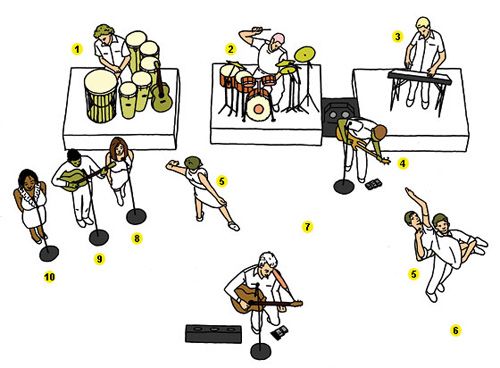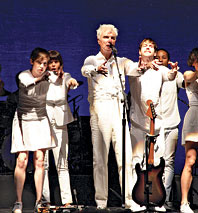

David Byrne Makes Sense Of His Tour
By Rebecca Milzoff, New York Magazine, 22 February 2009 [Link]

Illustration by Mark Nerys
Last spring, as David Byrne was finishing his first album with Brian Eno in 28 years, Everything That Happens Will Happen Today, he came to a bittersweet realization: “It felt wonderful singing the songs, and I knew if I didn’t tour, then the recording process would be the last time for quite a while that I’d enjoy performing them—except in the shower.” The tour, subtitled “Songs of David Byrne and Brian Eno,” evolved from a set of Everything songs into a production that features selections from all of the duo’s collaborations (including the monumental My Life in the Bush of Ghosts and some Talking Heads songs). “I realized I could tie the present to the past with the thematic thread of Brian’s involvement,” says Byrne, who noticed, for instance, that “Poor Boy” (new) and “Crosseyed and Painless” (old) were both structured around just one or two chords. Sixty-nine performances in seven countries and only one wardrobe malfunction later (“The audience got so enthusiastic all of a sudden”), the show stops at Radio City this Friday and Saturday. Byrne deconstructed the intricate production (including seven musicians, three dancers, choreography, and costumes) while on a ferry to New Zealand’s Waiheke Island—ever-present bike at hand.
1. Mauro Refosco
Percussion and Guitar
The show is a true collaboration. “Mauro suggested that [a dancer] give the drummer his cutoff cue at the end of ‘Life During Wartime.’ A simple but brilliant idea.”
2. Graham Hawthorne
Drums
Byrne has worked with the rhythm section for ten years. Hawthorne “also does programming and wine recommendations.”
3. Mark Degliantoni
Keyboards
Former member of Soul Coughing with whom Byrne did some shows “back in the day.”
4. Paul Frazier
Bass and Vocals
Another longtime associate of Byrne’s—a “great singer” in addition to his instrumental talents. Co-founded the Funky Poets rap group in the nineties.
4. The Set
“It’s really simple—generic even,” with one strange component: four office chairs, used in one number. “I’d suggested that we do a dance in a chair, and I think the next day in rehearsal [choreographer] Annie-B showed me a rough version— I loved it! It was silly but somehow really moving at the same time.”
5. The Dancers
“I thought to myself, No one would expect me to bring dancers! They’ll think it must be pretentious or that corny MTV-video stuff everyone does. Dealing with those prior assumptions might be fun.” Byrne participated in the casting process, adamant that the dancers “should not look like typical dancers—you know, how you can always spot a dancer around Lincoln Center.” He wasn’t initially sure the concept would work, but now feels “it lifts the show to another level. Well, you’ll see—it was a great relief. Whew.”
6. The Choreography
Annie-B Parson, Noémie LaFrance, and Layla Childs and Sonya Robbins contributed. “The movement vocabulary isn’t rooted in modern, jazz, or ballet: We’ve all seen a lot of that already.” Byrne offered ideas too. He was inspired by two Japanese films—The Taste of Tea and Funky Forest (both “have hilarious and unexpected dance sequences”)—and by Sufjan Stevens’s The BQE at BAM, which incorporated video and hula-hooping.
7. “Dancerville”
Production manager Mark Edwards came up with this nickname for “watch out for moving bodies in this area.”
8. Jenni Muldaur
Singer
Byrne’s manager suggested Muldaur. “We have a lot of friends in common, which helps the conviviality on the road—a serious issue over a long tour.”
9. Redray Frazier
Singer and Guitar
Brother of bass player Paul. “It’s nepotism of the best sort … a lucky coincidence, really.”
11. Kaïssa
Singer
Byrne met the Cameroonian singer at Paul Simon’s recent bam retrospective, in which they both participated (Byrne at one point sang backup for Kaïssa). “We hit it off immediately.”

The Costumes
“Lots of bands find [coordinated outfits] offensive, as if their individuality were being taken away—then they wear some version of an alt-rock or metal uniform.” For this show, everyone wears white. “There were some groans—‘OMG, I’m going to have to lose weight,’ ”—but white is practical (helps the lighting designer illuminate the cast) and meaningful (“The music is vaguely spiritual—as we know, white is what everyone wears in heaven”).

